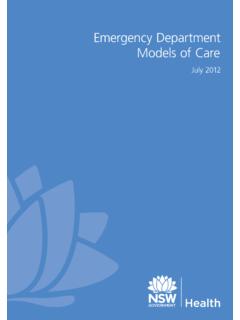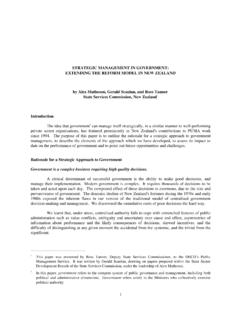Transcription of Guidance on the Role and Effective Use of …
1 1 Guidance on the Role and Effective Use of Chaperones in Primary and Community care settings model chaperone FRAMEWORK June 2005 2 INDEX Page No 1. Introduction 3 2. Scope of Guidance 3 3. Background 4 4. General Issues 4 5. Role of the chaperone 5 6.
2 Type of chaperone 5 7. Use of Virtual Chaperones 6 8. Training for Chaperones 7 9. Offering a chaperone 7 10. Where a chaperone is needed but not available 8 11. Consent 9 Special Circumstances 9 12.
3 Issues specific to children 9 13. Issues specific to religion/ethnicity/culture 10 14. Issues specific to learning difficulties/mental health problems 10 15. Lone working 11 16. During the examination/procedure 11 17. Communication and record keeping 12 18. Wearing of gloves 13 19.
4 Summary 13 20. Further information 14-15 Appendix A - Sample chaperone Policy 16-17 Appendix B - Sample Patient Notification 18 31. INTRODUCTION This paper sets out Guidance for the use of chaperones and procedures that should be in place for consultations, examinations and investigations. This paper does not constitute national policy or guidelines and should not be seen to replace any other professional Guidance or organisational polices.
5 However, it does represent a distillation of current good practice across health care organisations. This is also aimed at providing practical advice to healthcare professionals working in a variety of locations where availability of a chaperone may not always be possible. All medical consultations, examinations and investigations are potentially distressing. Patients can find examinations, investigations or photography involving the breasts, genitalia or rectum particularly intrusive (these examinations are collectively referred to as intimate examinations ). Also consultations involving dimmed lights, the need for patients to undress or for intensive periods of being touched may make a patient feel vulnerable. For most patients respect, explanation, consent and privacy take precedence over the need for a chaperone . The presence of a third party does not negate the need for adequate explanation and courtesy and cannot provide full assurance that the procedure or examination is conducted appropriately.
6 Every primary care organisation that has direct contact with patients should have a chaperone policy in place for the benefit of both patients and staff. Primary care organisations that are responsible for primary care contractors should have model frameworks in place for local dissemination. 2. SCOPE OF Guidance This paper applies to all healthcare professionals working within an organisation, including medical staff, nurses, health care assistants, allied health professionals, medical students, radiographers and complementary therapists working with individual patients in surgeries, clinic situations, wards, departments, out-patient and in the patient s home. This Guidance also covers any non-medical personnel who may be involved in providing care . In this Guidance all staff groups covered will be referred to as the healthcare professional.
7 The use of the feminine gender equally implies the male and similarly the use of the male gender equally implies the female. 43. BACKGROUND Recent public inquiries, such as the Clifford Ayling Inquiry, have made a number of recommendations into the use of chaperones in primary and community care settings, specifically around who should undertake the role of chaperone and the training for the role. These recommendations have been discussed in the light of practicality and suitability for primary and community care and with a wide range of stakeholders and this Guidance reflects those discussions. The majority of the research into the use of chaperones has been limited to general practice. A study looking at attitudes of patients towards the use of chaperones carried out in Tyneside found that 90% of female patients and 78% of male patients thought that a chaperone should be offered for intimate examinations.
8 It is clear from available research that the use of chaperones is increasing with male doctors use of chaperones recorded at 68%, although use of chaperones by female doctors remains low at 5%. About one third of GP practices have a chaperone policy in place, although it is not clear what this entails. Practice nurses are the most commonly used chaperones (78%) with family member/friend (47%) and non-clinical staff (43%) listed as alternatives. In 60% of cases the chaperone is stationed beside the patient, whilst in 36% the chaperone remains outside the curtain. The offer of a chaperone and their presence is recorded in medical notes in less than a third of cases. The most commonly identified issues that restrict the offer and use of chaperones were availability of chaperones and time constraints when one is required. 4.
9 GENERAL ISSUES Chaperones are most often required or requested where a male examiner is carrying out an intimate examination or procedure on a female patient. Complaints involving allegations of improper examination by a doctor are very rare. Where allegations of indecent assault during a clinical examination do occur almost all are against a male doctor and a small but significant minority of cases involve a male doctor and a male patient. However, it is good practice for a health organisation to offer all patients a chaperone for any consultation, examination or procedure where the patient feels one is required. This offer can be made through a number of routes including prominently placed posters, practice leaflets and verbal information prior to the actual consultation. It is not always clear ahead of the consultation that an intimate examination or procedure is required.
10 It may be wise, especially where a male clinician examines a female patient to repeat the offer of a chaperone at the time of the examination. 5 Adequate information and explanation as to why the examination or procedure is required should be provided and where necessary, easily understood literature and diagrams can support this verbal information. In addition, careful and sympathetic explanation of the examination technique to be used should be given throughout the procedure being carried out. It is unwise to assume that the patient understands why certain examinations are being conducted or why they are done in a certain manner. For example, patients need to be told why both breasts are examined when they may complain of a lump in only one, or why a vaginal examination maybe necessary if a women complains of abdominal pain or why the testes may be examined in a child with abdominal pain.











